In the shadow of Haleakalā, the 10,023-foot high volcanic mountain that looms over Hawai’i’s eastern Maui Island, lies Kaupō, one of the twelve districts (moku) of the island’s ancient kingdom. Today Kaupō is a sleepy backwater whose few permanent residents are mostly engaged in ranching. But around A.D. 1710, almost seven decades before British Captain James Cook broke the immense sea barrier that had isolated the Hawaiian archipelago from the rest of the world for half a millennium, Kaupō was the royal seat of King Kekaulike. Kekaulike, revered to this day by Native Hawaiians on Maui, was a descendant of the great Pi’ilani, who for the first time unified the island kingdom around A.D. 1570. (The stone foundations of Pi’ilani’s huge temple and royal residence can still be seen at Kahanu Gardens, just outside the little town of Hāna.)
Kekaulike was an ali’i akua, literally a “god king.” In the complex and hierarchical society that had evolved in the Hawaiian Islands over the centuries prior to Kekaulike’s reign, the highest ranked chiefs or ali’i had become divine kings, tracing their genealogies back to the gods. To preserve and intensify their blood lines, these elites practiced so-called pi’o (“arched”) marriages between brother and sister, or between half-siblings. Kekaulike married his own half-sister Keku’iapoiwanui to produce a sacred heir, Kamehamehanui. Such royal incest had similarly been practiced by the Pharaohs of ancient Egypt as well as by the Inca of Peru, other ancient societies that anthropologists call “archaic states.” The Hawaiian god-kings were considered so sacred (kapu) that they could not be gazed upon by mere commoners; hence they often traveled at night, to avoid being seen. Should they pass in the presence of a commoner, the latter would have to perform the kapu moe (prostrating taboo), lying face-down on the ground. A stolen glance at the passing god-king, resplendent in his cloak and helmet of rare red and yellow birds’ feathers (Figure 1), could bring instant death from the warrior guard.
_________________________________________________________________________________________
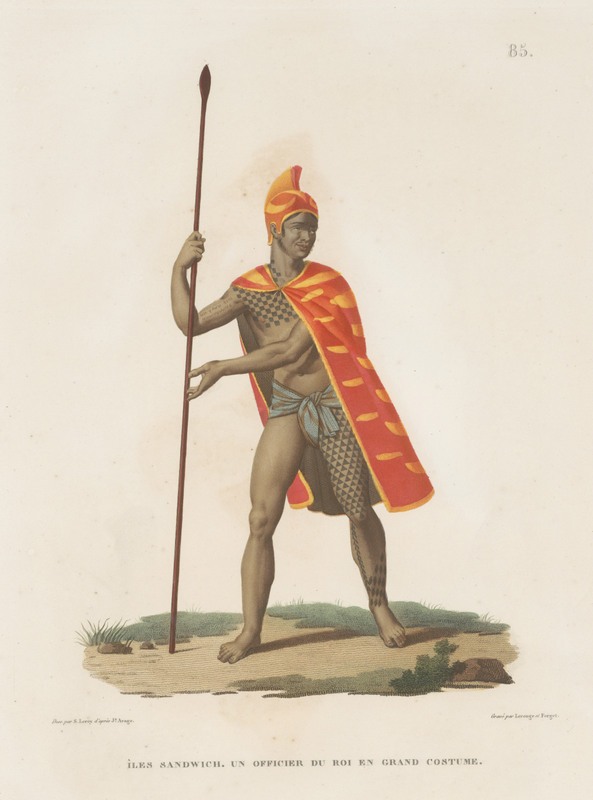 Figure 1: A Hawaiian chief in his feathered cloak and helmet, as drawn by the French artist Arago in 1819 (Courtesy of the Bancroft Library, University of California, Berkeley).
Figure 1: A Hawaiian chief in his feathered cloak and helmet, as drawn by the French artist Arago in 1819 (Courtesy of the Bancroft Library, University of California, Berkeley).
_________________________________________________________________________________________
The Hawaiian society of Kekaulike’s time preserved its royal genealogies and histories through a highly developed system of oral tradition, memorized and transmitted from generation to generation by specially trained bards. In the mid-nineteenth century, after the arrival of Protestant missionaries who developed an alphabet and introduced literacy to this previously oral-aural culture, several knowledgeable sages began to commit the ancient traditions to writing. One of these was Samuel Mānaiakalani Kamakau, who authored a lengthy work known as Ruling Chiefs of Hawai’i. Kamakau tells us that in the early 1700s Kekaulike, having moved the royal seat from Hāna to Kaupō, was “engaged in building luakini heiaus for his gods.” A luakini was a temple (heiau) dedicated to the god of war, the fearsome Kū, who demanded human sacrifices at the dedication of his temple. Success in war required the construction and dedication of such a temple, often massive structures of dry-stacked stone masonry topped by carved wooden images, offering platforms, oracle towers, and other wooden structures. Kamakau also informs us that Kekaulike had his sights set on nothing less than the invasion and conquest of the “Big Island” of Hawai’i, facing Kaupō across the rough ‘Alenuihāhā Channel. To this end Kekaulike had assembled a formidable army and fleet of war canoes, ready to be launched from the bay of Mokulau.
_________________________________________________________________________________________
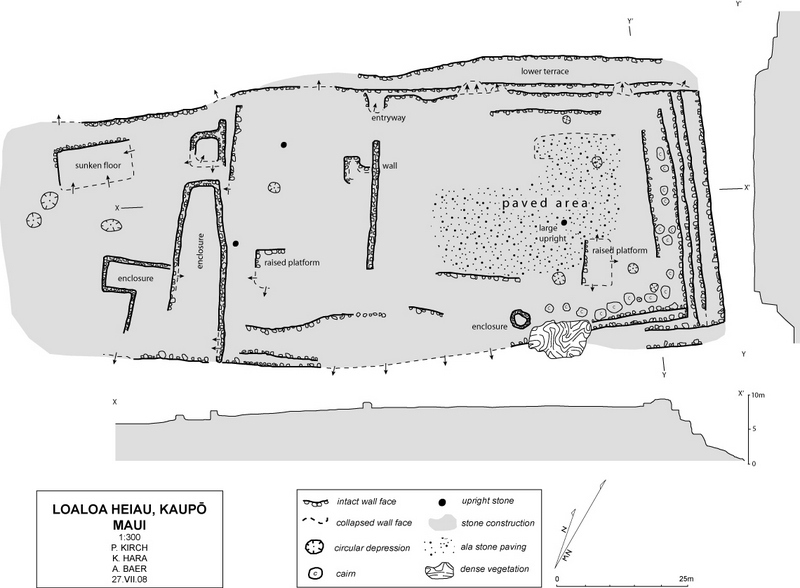
Figure 2: Plan map of Lo’alo’a heiau in Kaupō.
_____________________________________________________________________________________________________________________
One of the luakini temples built by Kekaulike, named Lo’alo’a, is well known to archaeologists. An imposing rectangular stone platform with a basal area of 44,800 square feet and a terraced front rising 30 feet from the ground, Lo’alo’a took countless hours of human labor to construct (Figure 2). But Kamakau tells us that Kekaulike also dedicated a second temple, Kanemalohemo, at a place called Pōpōiwi. Kanemalohemo was not as well recorded archaeologically, although its general location was known, on a hillside thoroughly overgrown with thick Christmas berry and other invasive plants. A few years ago, I decided to have a look at Kanemalohemo for myself. Perhaps it would provide some new insights into the society of the Hawaiian god-kings.
Finding the Second Temple
My graduate student Alex Baer was conducting an archaeological survey of Kaupō for his doctoral dissertation at Berkeley. Before he departed for Maui, I showed Alex the general location on the map where the ruins of Kanemalohemo should lie, obscured by thick vegetation. “See if you can manage to hack your way into that thick brush and find the main temple walls,” I told Alex in my Oceanic Archaeology Lab at Berkeley. “When I come out to visit later in the field season I’d like to try to make a map of the site.” Alex promised that he would make the relocation of Kanemalohemo a priority.
Some weeks later I flew into Maui; Alex met me at the airport with his rickety rental Jeep. Tossing my duffel bag into the back, I asked him if he had managed to find the ruins of Kanemalohemo. “You bet,” he grinned. Then he added: “You are going to be amazed at the size and extent of that site.” I couldn’t wait to see what he and his student assistant Kris Hara had found. A couple of hours later, Alex pulled the Jeep up a narrow dirt road and parked. Dank foliage hung over the rutted track; the humid air was thick with hungry mosquitoes. Slathering on repellent and picking up our machetes, Alex, Kris, and I plunged into the tropical vegetation, following a narrow trail they had cut a few days earlier.
After a couple of minutes we came into a more open space, where a giant candlenut tree shaded out the other vegetation. Looming up in front of us was a massive stone rampart, its rocks green with moss undisturbed for centuries. “My god,” I half muttered under my breath. “This thing is huge.” Alex suppressed a chuckle. “This is just one of the outer terraces. Wait until we get up on top of the main structure.”
For several hours the three of us explored the ruins of Kanemalohemo, covering roughly two continuous acres on the gentle slopes of Pōpōiwi, overlooking the bay of Mokulau. Alex and Kris had already spent several long days hacking away at the undergrowth with their machetes, so the main walls and terrace facings were now visible. Later, we would begin the laborious task of mapping the structure with plane table and alidade. For now, I just wanted to explore this site, linked in tradition with one of Maui’s most famous divine kings. We made our way up onto one of the two expansive main courts or plazas, paved with thousands of basket-loads of water-rounded pebbles hauled up from the beach at Mokulau. Alex tapped my shoulder. “Come over here, you’ve got to see this feature.”
We ducked under low-hanging Christmas berry branches, clambered over a stone wall and emerged on a small, well-paved terrace surmounting a promontory which overlooks the bay. Here the strong easterly winds that continually buffet Kaupō kept the wiry vegetation down to a few feet. I climbed out onto the perimeter wall and could see that I was on a kind of rampart supported by a massive stone facing that descended down the steep slope toward the coast (Figure 3). The facing was angled away from me like a sharp inverted Ʌ–one might say like the prow of a Polynesian canoe–with the point of the Ʌ facing directly toward Hawai’i Island. Struggling to keep from being blown over by the strong gusts as I balanced myself on the rounded boulders making up the rampart, I pulled my sighting compass out of my pocket. The bearing of the Ʌ-point was almost exactly the direction from here to Waipi’o Valley on Hawai’i Island. Waipi’o was the royal seat of the divine kings of Hawai’i Island, arch rivals and at the same time blood relatives of Kekaulike.
Backing off the windy rampart, Alex and I stood on the paved terrace and reflected on the importance of this site. We knew from Kamakau’s account that it was here that Kekaulike had assembled his warriors and fleet for his intended conquest of Hawai’i. Was this special terrace, so carefully paved with beach pebbles and with the Ʌ-shaped rampart seemingly directed at Waipi’o, the place where Kekaulike himself had once sat, cross-legged on fine mats, gazing at his goal, plotting his strategy? It seemed entirely possible.
That evening, after a well-earned meal of BBQ’d Maui steaks, the three of us sat on the porch of the hunting cabin at Nu’u which was Alex’s field base. Enjoying the spectacular stars, we engaged in a kind of informal seminar. These are always the best teaching moments with my students. In this case it was after a long day of fieldwork, reflecting on the significance of our hard work clearing thorny brush off of moss-covered walls.
“Hawai’i,” I said, pausing to take a long draw on my cigar, “is the last place on Earth where a true archaic state emerged.” Kris interjected to ask what I meant by the term archaic state. “An archaic state is one that was ruled by divine kings, like Kekaulike was, with a formal priesthood, and with distinct commoner and elite classes,” I replied. I told her that archaic states were sometimes called “pristine states,” because they had emerged out of simpler forms of sociopolitical organization, what anthropologists typically call “chiefdoms.” The early civilizations in Mesopotamia, Mesoamerica, China, Egypt, and the Andes, were all archaic states.
Alex challenged me. “But most anthropologists and archaeologists have previously classified Hawai’i as a complex chiefdom, not an archaic state. That’s what Marshall Sahlins and Tim Earle have written in the books you assigned in your seminar at Berkeley.” Nothing like a good graduate student to keep you on your toes. “You’re absolutely correct Alex; I used to believe that as well. But in recent years I’ve come to question that view. I’m now finishing a book called How Chiefs Became Kings. It lays out in detail the argument for why the late pre-contact Hawaiian society should be considered a group of archaic states, rather than chiefdoms.”
From Chiefs to Divine Kings
As the evening wore on and the fire’s embers dimmed, we talked at length about how new research was changing our ideas about how Hawaiian society had evolved over eight centuries. The Hawaiian archipelago was discovered by Polynesian voyagers in their double-hulled canoes around A.D. 1000. These intrepid colonists brought with them crop plants such as taro and yams, and domesticated animals (pigs, dogs, and chickens), ready to establish a new society. They found a vast, resource-rich archipelago of subtropical islands in which their descendants could flourish.
And flourish they did. The valleys and streams of the older islands such as O’ahu and Kaua’i provided ample scope for developing extensive irrigation works in which to grow taro. On the younger islands, the fertile volcanic soils were conducive to yam and sweet potato farming. The reefs and inshore waters offered an abundance of fish and shellfish. The population was not afflicted by any of the main diseases of the Old World; consequently, the Hawaiian population grew at an exponential rate.
For at least two or three centuries after the arrival of the first Polynesian colonists, contacts with the homeland islands such as Tahiti in the South Pacific were maintained through occasional two-way voyages in the great double-hulled canoes. Hawaiian traditions still refer to the famous voyages made by such chiefs as Mo’ikeha, Kila, and Pā’ao. But after the end of the fourteenth century these voyages ceased for reasons that have never been fully explained. Hawai’i became totally isolated from the rest of the world. The bards kept a memory of the ancestral homeland of “Kahiki” (Tahiti), but henceforth the path of social and political evolution was completely driven by internal forces.
By A.D. 1400 the Hawaiian population had densely occupied what my colleague Robert Hommon once called the “salubrious core regions” of the islands. These were the most favorable ecological zones, especially the valleys with permanent streams amenable to irrigation. The population began to expand into the drier, leeward regions, such as the vast slopes of Kohala and Kona on Hawai’i Island, as well as across the similarly leeward regions of Kahikinui and Kaupō on Maui. Farming in these regions was not as highly productive as in the irrigated zones, but nonetheless the fertile volcanic soils produced good yields of sweet potato and dryland taro. Moreover, these dryland regions were extensive, allowing for further population growth and for a level of surplus production that the chiefs could tap into to fuel their political aspirations. Through his survey work, Alex Baer has shown that much of Kaupo was once covered in the rock walls and embankments of an intensive field system (Figure 4). This field system provided the surplus that Kekaulike drew upon to support his warriors and attendants.
________________________________________________________________________________________
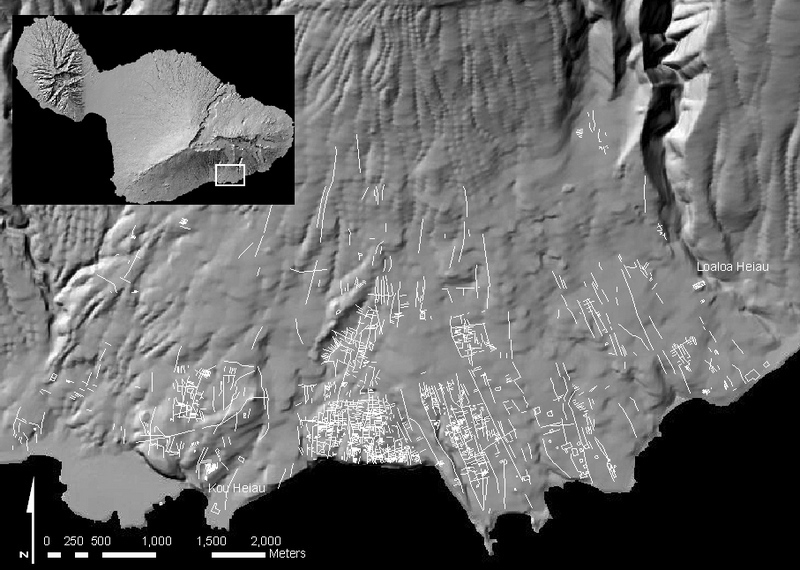 Figure 4: Digital elevation map of the Kaupō region (inset shows the island of Maui). The lines indicate ancient field system walls and embankments mapped through aerial photography.
Figure 4: Digital elevation map of the Kaupō region (inset shows the island of Maui). The lines indicate ancient field system walls and embankments mapped through aerial photography.
________________________________________________________________________________________
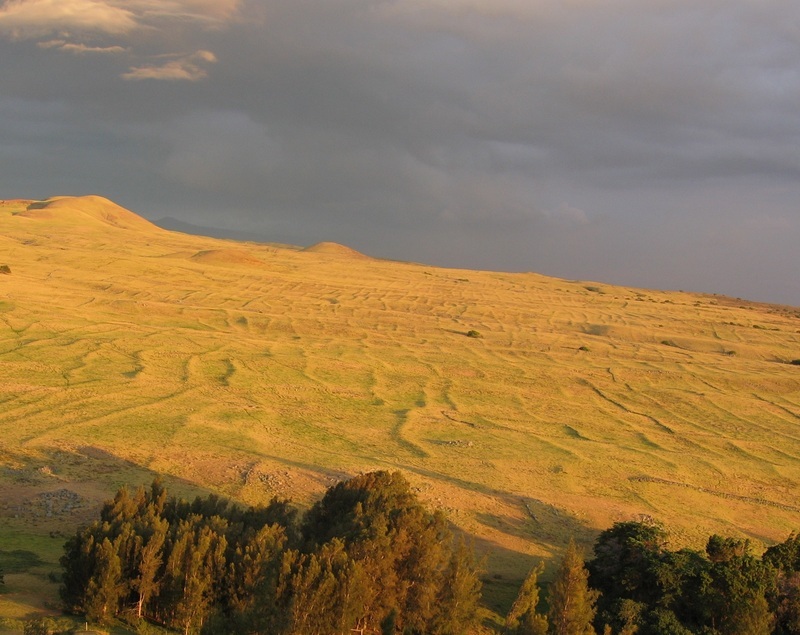
Figure 5: Rows of ancient agricultural field embankments can still be seen from the summit of Pu’u Kehena on Hawai’i Island. These are remnants of what at one time was a vast, sophisticated system capable of supporting a relatively large population.
All Polynesian societies are based on principles of chiefly rank. The ancient Polynesian word for chief, ariki, is found in virtually every Polynesian society; its Hawaiian variant is ali’i. In an earlier time in Hawai’i, the ali’i would have simply been the members of the higher-ranked families, the first-born of the first-born. But over time, as the population expanded to encompass not just thousands but tens of thousands of people, the ali’i began to compete among themselves for increased status and power. Fine gradations between ali’i began to be developed, ultimately resulting in nine distinct ranks of elites.
At the same time, distinctions between the ali’i and the common people became more marked. In Hawai’i, the word for commoners at the time of European contact was maka’āinana. As with the word for chief, this term can be traced back to its deep roots in ancestral Polynesian society, where it originally meant the group of descendants of a common ancestor. The ancient word was mata–kāinanga, which gradually changed in Hawaiian to maka’āinana. But more than mere sound changes were involved, for while the original term referred to a group of kinsmen who shared a common territory and held rights to farm that land, the new word indexed the common people who worked the land by virtue of their tributary relationship to their chiefs.
The greatest change that sets Hawaiian society off from its Polynesian relatives was in the system of land tenure. Throughout virtually every other Polynesian society (Tonga is one other exception), access to land was by virtue of one’s membership in a hereditary social group (such as a mata–kāinanga). But in Hawai’i–at the time of European contact–the land tenure system was one of extensive territories called ahupua’a (often comprising a single valley) which were held by the prominent chiefs. Each ahupua’a was overseen by a konohiki or manager, who made certain that the individual commoner families not only worked their individual plots, but provided regular labor to communal projects such as repairing the irrigation works. More importantly, the konohiki ensured the regular production of surplus food stuffs and other goods which provided the necessary support for the chiefly households and for the king’s own establishment.
When did this fundamental transformation in Hawaiian society–from an older form of Polynesian chiefship to that of an emergent archaic state–occur? Recent research points to the time period around the close of the sixteenth century and beginning of the seventeenth century. According to the royal genealogies it was then that Pi’ilani and his son Kiha-a-Pi’ilani consolidated the Maui kingdom. At the same time on Hawai’i Island, the famous ‘Umi-a-Liloa defeated his half-brother Hākau and launched a series of wars of conquest against the previously independent chiefs of Hawai’i Island. ‘Umi-a-Liloa and Kiha-a-Pi’ilani were linked through the marriage of Kiha’s sister Pi’ikea to ‘Umi. Thereafter, the royal houses of Maui and Hawai’i would continue to elaborate the practices of divine kingship and vie between them for ultimate control of the entire archipelago.
But what of Kekaulike, the descendant of Pi’ilani who once sat on his fine mats at Kanemalohemo, gazing out across the foamy ‘Alenuihāhā Channel, plotting his conquest of fair Hawai’i? The old sage Kamakau recounts Kekaulike’s fate in the pages of Ruling Chiefs of Hawai’i. Kekaulike launched his war canoes at Mokulau, sailing across the channel past Kohala to descend unsuspected upon the Kona district of Hawai’i. The Maui forces took Hawai’i by surprise, devastating the productive field system, cutting down the old breadfruit trees. Then warriors under the command of Alapa’inui, the Hawai’i king, counterattacked, forcing the Maui troops back to their canoes. Fleeing north along the Kohala coast, the Maui warriors cut down all the coconut trees; they slaughtered any commoners in their path, seizing their possessions.
Kekaulike’s forces returned to Mokulau in Kaupō. The Maui king offered sacrifices to Kū at his luakini temples, making plans for a re-invasion of Hawai’i. But his rival Alapa’inui had been incensed by the cowardly way in which the Maui invaders had behaved, destroying productive plantations and attacking defenseless commoners. Before Kekaulike had time to prepare his troops, word came that the Hawai’i Island fleet was enroute across the channel. Kekaulike, according to Kamakau’s account, was seized with a violent illness, a kind of epilepsy, which the Hawaiians called ka maka huki lani, or “eyes drawn heavenward.” With his principal chiefs, Kekaulike fled Kaupō, giving over the kingship to his sacred son Kamehamehanui. When Alapa’inui arrived at Kaupō, he heard that Kamehamehanui was now the king. Kamehamehanui was in fact Alapa’inui’s own nephew, for the new king’s mother Keku’iapoiwanui was Alapa’inui’s sister! Such were the close familial relationships between the divine kings of ancient Hawai’i. Alapa’inui called off his war of revenge against Maui.
In this short article I have only given the barest glimpse into the fascinating history of ancient Hawai’i, through the lens of just one of the islands’ many archaeological sites–Kanemalohemo–and its builder, Kekaulike. The rise of archaic states in these islands, from ancestral Polynesian chiefdoms, is an ongoing topic of archaeological research. For readers who would like to delve more deeply into the remarkable history of the islands, I invite you to explore the pages of my recent book, A Shark Going Inland is my Chief: The Island Civilization of Ancient Hawai’i.
_________________________
Cover Photo, Top Left: View of a great ancient Hawaiian temple, with valley in background. Gillfoto, Wikimedia Commons
______________________________________________________________________________________________________
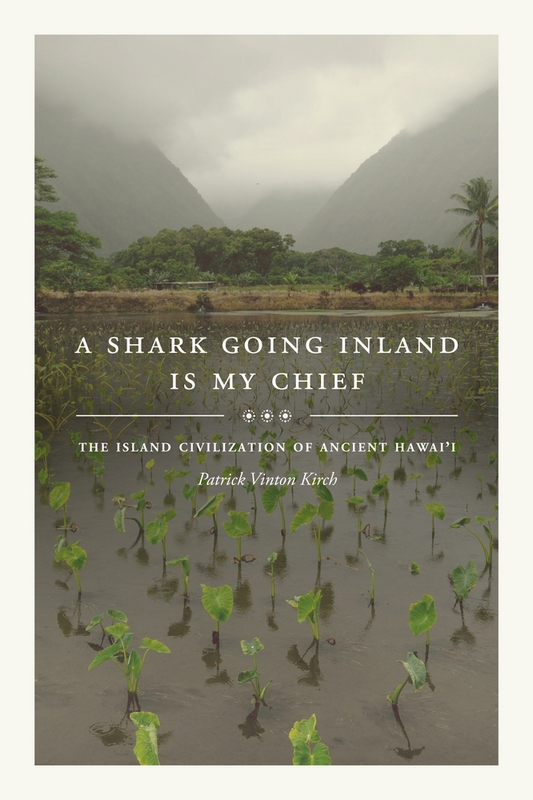 Interested readers may purchase the book, A Shark Going Inland Is My Chief, at the University of California Press website.
Interested readers may purchase the book, A Shark Going Inland Is My Chief, at the University of California Press website.

______________________________________________
Travel and learn with Far Horizons.
____________________________________________
This richly illustrated issue includes the following stories: Recent findings shedding new light on the whereabouts of the remains of Philip of Macedon, father of Alexander the Great; how an archaeologist-sculptor is bringing bones of the dead back to life; archaeologists uncovering town life at the dawn of civilization; an exclusive interview with internationally acclaimed archaeologist James M. Adovasio about what makes the Meadowcroft Rockshelter prominent in the ongoing search for the first Americans; what archaeologists are finding at the site of the ancient city of Gath, the home town of the biblical Philistine giant, Goliath; and how scientists are redrawing the picture of human evolution in Europe. Find it on Amazon.com.






